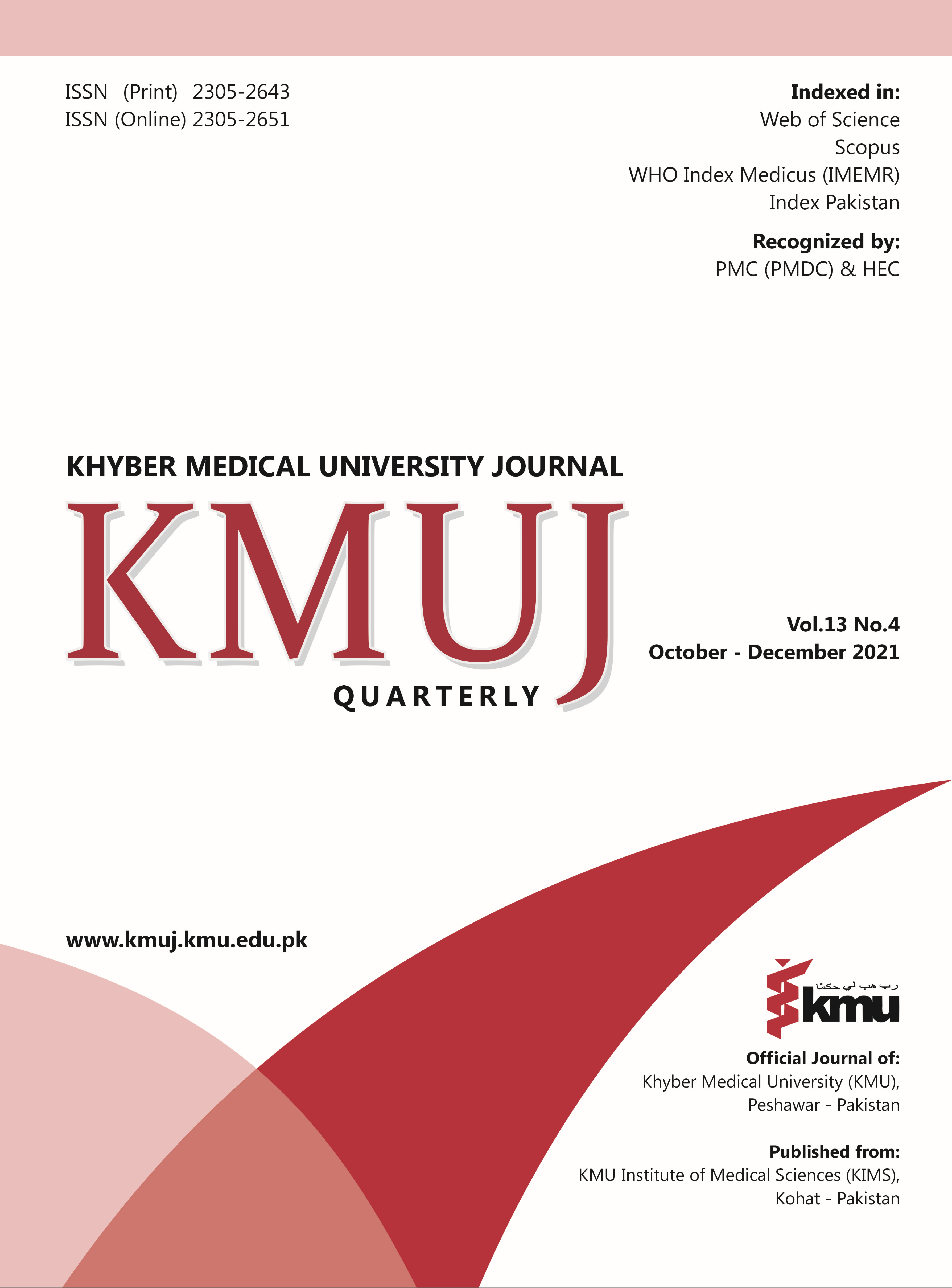IMPACT OF NUTRITIONAL STATUS ON INDUCTION MORTALITY IN PAEDIATRIC ACUTE LYMPHOBLASTIC LEUKAEMIA
Main Article Content
Abstract
OBJECTIVE: To study the impact of nutritional status on induction mortality among pediatric patients suffering from acute lymphoblastic leukemia (ALL).
METHODS: This descriptive analytical study was conducted on pediatric ALL patients who completed induction chemotherapy in Pediatric Oncology Department Combined Military Hospital, Rawalpindi, Pakistan from 1st January 2012 to 30th June 2021. All patients of ALL diagnosed on basis of National Comprehensive Cancer Network Clinical Practice Guidelines, aged 1-18 years were included. Patients who left before completion of induction chemotherapy or refused to participate were excluded. Cases were divided into three groups based on nutritional status. Induction chemotherapy was given as per UKALL 2011 protocol.
RESULTS: Out of 926 patients diagnosed with ALL, 586 (63.3%) were males and 340 (46.7%) were females. Mean age of patients was a 5.83±3.627 years. Majority of the patients (n=679, 73.3%) were well-nourished; and 161 (17.4%) and 86 (9.3%) were moderately and severely malnourished, respectively. About 49.8% (n=461) patients received standard risk chemotherapy protocol with three-drug induction and 50.2% (n=465) received four-drug induction chemotherapy. Infection was the most common complication in 742 (80.1%) patients. Overall induction mortality was 12.9% (n=119/926) in all patients including 9.54% (n=44/461) in standard-risk and 16.12% (n=75/465) in high-risk patients (p=0.003). Induction mortality was significantly high in malnourished-group (17.8%) and 12.2% in normally-nourished children (p=0.008).
CONCLUSION: Nutritional status and risk group at time of diagnosis emerged as predictors of induction mortality among ALL patients. Considerable number of patients died during induction phase of treatment. Malnourished children have a high mortality rate.
Article Details
Work published in KMUJ is licensed under a
Creative Commons Attribution 4.0 License
Authors are permitted and encouraged to post their work online (e.g., in institutional repositories or on their website) prior to and during the submission process, as it can lead to productive exchanges, as well as earlier and greater citation of published work.
(e.g., in institutional repositories or on their website) prior to and during the submission process, as it can lead to productive exchanges, as well as earlier and greater citation of published work.
References
Terwilliger T, Abdul-Hay M. Acute lymphoblastic leukemia: a comprehensive review and 2017 update. Blood Cancer J 2017;7(6):e577. https://doi.org/10.1038/bcj.2017.53.
Sas V, Moisoiu V, Teodorescu P, Tranca S, Pop L, Iluta S, et al. Approach to the Adult Acute Lymphoblastic Leukemia Patient. J Clin Med 2019;8(8):1175. https://doi.org/10.3390/jcm8081175.
Bhojwani D, Howard SC, Pui CH. High-risk childhood acute lymphoblastic leukemia. Clin Lymphoma Myeloma 2009;9(Suppl 3):S222-30. https://doi.org/10.3816/CLM.2009.s.016.
Rogers PC. Importance of nutrition in pediatric oncology. Indian J Cancer 2015k;52:176-8. https://doi.org/10.4103/0019-509X.175830.
Paviglianiti A. A review on the impact of body mass index on outcomes in pediatric leukemia. J Blood Med 2020;18;11:205-12. https://doi.org/10.2147/JBM.S232655.
Yazbeck N, Samia L, Saab R, Abboud MR, Solh H, Muwakkit S. Effect of Malnutrition at Diagnosis on Clinical Outcomes of Children With Acute Lymphoblastic Leukemia. J Pediatr Hematol Oncol 2016;38(2):107-10. https://doi.org/10.1097/MPH.0000000000000428.
Antillon F, Rossi E, Molina AL, Sala A, Pencharz P, Valsecchi MG, et al. Nutritional status of children during treatment for acute lymphoblastic leukemia in Guatemala. Pediatr Blood Cancer 2013;60(6):911-5. https://doi.org/10.1002/pbc.24377.
Lobato-Mendizábal E, Ruiz-Argüelles GJ, Marín-López A. Leukaemia and nutrition I: Malnutrition is an adverse prognostic factor in the outcome of treatment of patients with standard-risk acute lymphoblastic leukaemia. Leuk Res 1989;13(10):899-906. https://doi.org/10.1016/0145-2126(89)90043-x.
Marín-López A, Lobato-Mendizabal E, Ruiz-Argüelles GJ. Malnutrition is an adverse prognostic factor in the response to treatment and survival of patients with acute lymphoblastic leukemia at the usual risk. Gac Med Mex 1991;127(2):125-31.
American Society of Parenteral and Enteral Nutrition. Guidelines for the Use of Parenteral and Enteral Nutrition in Adult and Pediatric Patients. Section IV: Nutrition assessment - Pediatrics. J Parenter Enteral Nutr 2002;26 (Suppl 1):13SA-17SA. https://doi.org/10.1177/0148607102026001011
Murry DJ, Riva L, Poplack DF. Impact of nutrition on pharmacokinetics of anti-neoplastic agents. Int J Cancer 1998; Suppl 11: 48-51. https://doi.org/10.1002/(sici)1097-0215(1998)78:11+<48::aid-ijc14>3.0.co;2-3.
Mejia-Arangure JM, Fajardo-Gutierrez A, Reyes-Ruiz NI et al. Malnutrition in childhood lymphoblastic leukemia: A predictor of early mortality during the induction-to-remission phase of the treatment. Arch Med Res 1999;30:150-3. https://doi.org/10.1016/s0188-0128(98)00026-8.
Ghafoor T, Ahmed S, Khalil S, Farah T. Impact of Malnutrition on Treatment Outcome of Paediatric Acute Myeloid Leukemia. J Coll Physicians Surg Pak 2020;30(10):1021-5. https://doi.org/10.29271/jcpsp.2020.10.1021.
Puckett Y, Chan O. Acute lymphocytic leukemia. [Updated 2020;18]. In: StatPearls. Treasure Island (FL): StatPearls Publishing; 2021. Available from URL: https://www.ncbi.nlm.nih.gov/books/NBK459149/
Jafari S, Fouladgar M, Naeeni MM, Fakhri M, Fatemi SA, Heidari K, et al. Body mass index, weight-for-age, and stature-for-age indices in iranian school children in relation to weight and growth disorders: a population-based survey. Int J Prev Med 2014;5(Suppl 2):S133-8. https://doi.org/10.4103/2008-7802.157674.
Schultz KR, Pullen DJ, Sather HN, Shuster JJ, Devidas M, Borowitz MJ, et al. Risk- and response-based classification of childhood B-precursor acute lymphoblastic leukemia: a combined analysis of prognostic markers from the Pediatric Oncology Group (POG) and Children's Cancer Group (CCG). Blood 2007;109(3):926-35. https://doi.org/10.1182/blood-2006-01-024729.
Goulden NJ, Kirkwood AA, Moppett J, Samarasinghe S, Lawson S, Rowntree C, et al. UKALL 2011: randomised trial investigating a short induction dexamethasone schedule for children and young adults with acute lymphoblastic leukaemia. Blood 2017;130 (Supplement 1):141. https://doi.org/10.1182/blood.V130.Suppl_1.141.141.
Nakagawa S, Kato M, Imamura T, Imai C, Koh K, Kawano Y, et al. In-Hospital Management Might Reduce Induction Deaths in Pediatric Patients With Acute Lymphoblastic Leukemia: Results From a Japanese Cohort. J Pediatr Hematol Oncol 2021;43(2):39-46. https://doi.org/10.1097/MPH.0000000000001926.
Kadenczki O, Nagy AC, Kiss C. Prevalence of Undernutrition and Effect of Body Weight Loss on Survival among Pediatric Cancer Patients in Northeastern Hungary. Int J Environ Res Public Health 2021;4;18(4):1478. https://doi.org/10.3390/ijerph18041478.
Tandon S, Moulik NR, Kumar A, Mahdi AA, Kumar A. Effect of Pre-treatment Nutritional Status, Folate and Vitamin B12 Levels on Induction Chemotherapy in Children with Acute Lymphoblastic Leukemia. Indian Pediatr 2015;52(5):385-9. https://doi.org/10.1007/s13312-015-0642-x.
Hafiz MG, Mannan MA. Nutritional status at initial presentation in childhood acute lymphoblastic leukemia and its effect on induction of remission. Mymensingh Med J 2008;17(2 Suppl):S46-51.
Diakatou V, Vassilakou T. Nutritional Status of Pediatric Cancer Patients at Diagnosis and Correlations with Treatment, Clinical Outcome and the Long-Term Growth and Health of Survivors. Children (Basel) 2020;7;7(11):218. https://doi.org/10.3390/children7110218.
